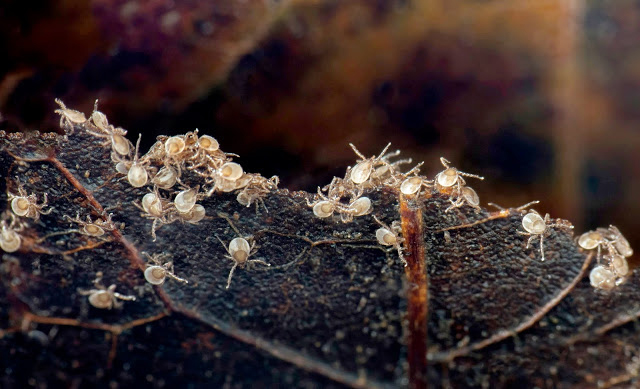
Ticks in their larval form are more prone to drying out and dying. Image: Graham Hickling
By Karen Hopper Usher
Ticks like it damp.
That’s the takeaway from a new paper by researchers trying to understand why people get Lyme disease more often in northern states.
Black-legged ticks carry the disease. They act differently down south, spending more time underneath leaf litter on the ground than they do in the north.
Researchers have been trying to understand why.
In a paper published in January in the journal Plos One, scientists from the U.S. Geological Survey, Michigan State University and the University of Rhode Island studied how ticks respond to high and low humidity.
Ticks die when it’s hot and dry, they found.

Ticks in their nymph stage spread the most disease. Image: Graham Hickling
“This is the first suggestion I know” that differences in climate affect tick behavior and that in turn can affect human health, said Howard Ginsberg, a research ecologist with the U.S. Geological Survey and the lead author of the study.
It’s poorly understood why southern states have a relatively low incidence of Lyme disease, Rebecca Osborn, a vector borne disease epidemiologist with the state of Wisconsin, wrote in an email.
“I have seen the study and found the objectives and study design compelling,” she said.
In northeastern states like Wisconsin and Rhode Island, black-legged ticks spend a lot of time on top of plants. When people walk by, it’s easy for ticks to climb aboard for a feast.
But in southern states such as Florida, the ticks hang out on the ground, under the leaf litter. When a bare-legged hiker walks through their territory, the ticks are underfoot instead of on top of a knee-high plant.
Now the researchers think they know one reason why the ticks down south are spending so much time under the leaf litter.
It’s because it’s damper underneath the leaf litter.

Larval ticks. Image: Graham Hickling
Researchers tested tick response in a lab. They used ticks from Rhode Island and ticks that were hybrids of Wisconsin and Florida ticks. Researchers replicated temperature and humidity of northern and southern summers and found ticks did better with high humidity.
The humidity hypothesis might not be mutually exclusive for other explanations for the difference in tick behavior, said Jean Tsao, a Michigan State University associate professor in fisheries and wildlife and large animal clinical sciences.
Host preferences could also be to blame. Up north, ticks use mice as hosts. Down south, they’re more likely to be found on lizards. And lizards are more likely to be found under the litter.
Tsao can’t say for certain which it is.

A tick in its nymph stage is displayed on a penny to show its small size. Image: Graham Hickling
But her team will be looking into it. The study published in January wasn’t even the main study.
“This was kind of a side study,” Ginsberg said. It was a byproduct of a large grant Tsao got to study the difference between new cases of Lyme disease in the north versus the south. Lyme disease is carried by ticks and can cause major problems affecting several bodily systems in humans.
The research is nearing the end, Tsao said.

Engorged nymph ticks. Image: Graham Hickling
They hope to wrap up work by this summer, Ginsberg said.
Eventually, Ginsberg wants to do a paper about ticks, Lyme disease and climate change, he said.
There’s already some evidence climate change means more ticks.
Ticks have spread geographically and are active earlier in Wisconsin, which has had a warmer and wetter climate in recent decades, Osborn wrote. That can increase the risk of Lyme disease.
In 2015, there were an estimated 3,267 new cases of Lyme disease in Wisconsin. Estimates for 2016 are expected in April, Osborn said.
Other northern states are also seeing more ticks and more lyme disease.
Nationally, 95 percent of new Lyme disease cases come from just 14 states: Connecticut, Delaware, Maine, Maryland, Massachusetts, Minnesota, New Hampshire, New Jersey, New York, Pennsylvania, Rhode Island, Vermont, Virginia and Wisconsin.